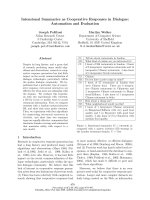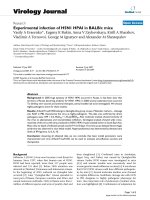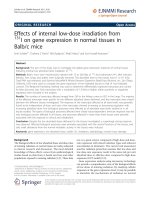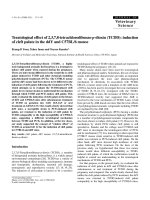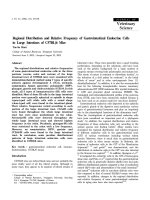Differential host immune responses in BALB c and C57BL 6 mice to burkholderia pseudomallei infection
Bạn đang xem bản rút gọn của tài liệu. Xem và tải ngay bản đầy đủ của tài liệu tại đây (1.63 MB, 166 trang )
i
DIFFERENTIAL HOST IMMUNE RESPONSES IN BALB/C
AND C57BL/6 MICE TO BURKHOLDERIA
PSEUDOMALLEI INFECTION
KOO GHEE CHONG
(B. SC (HONS.), NUS)
A THESIS SUBMITTED
FOR THE DEGREE OF DOCTOR OF PHILOSOPHY
DEPARTMENT OF BIOCHEMISTRY
NATIONAL UNIVERSITY OF SINGAPORE
2006
ii
Acknowledgements
I really would not have finished this project if not for the many people who have been
always there to inspire, love, guide, teach, support and motivate me during the past few
years of challenging journey that I have gone through.
I would like to express my heartfelt gratitude to my supervisor Dr Gan Yunn Hwen, for
her constant guidance, advice, patience and understanding. I would also like to thanks Ms
Lim Soh Chan for her constant help, technical support, advice, prayers, comments,
comforting and encouraging words.
I am grateful to all my friends and labmates, especially Sun Guang Wen, Lee Tien Huat,
Liu Boping, Xie Chao, Ong Yong Mei, Chen Kang, Chan Ying Ying, Cheryl Lee, Justin
Lee, Ng Kian Hong, Hu Huan, Wong Kok Lun, Ng Hui Ling, Hii Chung Shii, Chen
Yahua, Tang Soong Yew, Lim Kok Siong, Lu Guodong, Dawn Koh, Chan Mann Yin,
Bian Hao Sheng, Fei Wei Hua, Low Choon Pei, Clarence Kho, Jowett Wong, Lim Chih
Gang, Joshua Lau and many others for their assistance, encouragement and friendship.
To my parents and family members for their love, support and understanding all these
years. To brothers and sisters from my church for constantly keeping me in prayers. Most
of all, I am eternally thankful to God for sustaining me and bringing me through all the
difficulties, for constantly staying by my side and being the source of my strength,
inspiration and hope.
iii
Table of Contents
Contents Page
Title Page…………………………………………………………………………… i
Acknowledgements……………………………………………………………………….ii
Table of Contents……………………………………………………………………… iii
Summary………………………………………………………………………………….ix
List of Tables…………………………………………………………………………… x
List of Figures……………………………………………………………………………vii
List of Abbreviations……………………………………………………………………viii
Chapter 1 Introduction………………………………………………………………….1
1.1 Melioidosis………………………………………………………………………… 2
1.2 Prevalence and epidemiology……………………………………………………… 2
1.3 Melioidosis in Singapore…………………………………………………………… 4
1.4 Modes of transmission…………………………………………………………… 5
1.5 Clinical manisfestations…………………………………………………………… 5
1.6 Diagnosis…………………………………………………………………………… 7
1.6.1 Identification of Burkholderia pseudomallei……………………………………7
1.6.2 Serological tests…………………………………………………………………8
1.6.3 Molecular identification techniques…………………………………………… 9
1.7 Management and treatment … …………………………………………………… 9
1.8 Bacterial pathogensis……………………………………………………………… 11
1.8.1 Gene and genome………………………………………………………………11
1.8.2 Virulence factors……………………………………………………………….11
iv
1.9 Animals model for melioidosis…………………………………………………… 13
1.10 Role of cytokines in immunity………………………………………………… ….15
1.11 Objectives of present study…………………………………………………………18
Chapter 2 Characterization of B. pseudomallei mucosal infection model…… … 20
2.1 Introduction…………………………………………………………………………21
2.2 Materials and methods………………………………………………………… 23
2.2.1 Animals……………………………………………………………………… 23
2.2.2 Bacteria ………………………………………………………………………23
2.2.3 LD
50
determination… ……………………………………………………… 24
2.2.4 Infection of mice and preparation of organs………………………………… 24
2.2.5 RNA isolation and reverse transcription-polymerase chain reaction
(RT-PCR)………………………………………………………………………25
2.2.6 Determination of cytokines concentration by ELISA…………………………26
2.2.7 Flow cytometric analysis………………………………………………………26
2.2.8 Tissue pathology……………………………………………………………….27
2.2.9 Statistical analysis…………………………………………………………… 27
2.3 Results… ………………………………………………………………………….28
2.3.1 LD
50
of Burkholderia pseudomallei in BALB/c and C57BL/6 mice………….28
2.3.2 Bacterial loads in the infected organs……………………………… ……… 28
2.3.3 Cytokine Responses……………………………………………………………31
2.3.4 Kinetics of IFN-γ response upon low dose infection………………………… 32
2.3.5 IFN-γ response and bacterial loads in the blood of C57BL/6 mice upon high
dose infection………………………………………………………………… 34
v
2.3.6 Bacterial loads in organs of high dose and low dose challenged C57BL/6
mice…………………………………………………………………………….34
2.3.7 Pathology of infected organs………………………………………………… 36
2.3.8 Infiltration of immune cells during infection with B. peudomallei……………39
2.4 Discussion ……………………………………………………………………… 41
Chapter 3 Humoral immune response to Burkholderia pseudomallei………………47
3.1 Introduction………………………………………………………………………… 48
3.2 Materials and methods……………………………………………………………….53
3.2.1 Mice……………………………………………………………………………… 53
3.2.2 Bacteria…………………………………………………………………………….53
3.2.3 Expression of recombinant flagellin (r-FliC)……………… …………………….53
3.2.4 Purification of recombinant protein……………………………………………… 54
3.2.4.1 Preparation of cleared lysate under denaturing condition………………… 54
3.2.4.2 Purification of protein under denaturing condition………………………….55
3.2.4.3 Analysis of purified flagellin by SDS-PAGE……………………………….56
3.2.4.4 Determination of protein concentration by Bradford method …………… 56
3.2.4.5 Dialysis and concentration of purified flagellin…………………………… 56
3.2.5 Immunization of BALB/c mice …………………………………………… 57
3.2.6 Infection with live bacteria and protection study…………………………….57
3.2.7 Collection of serum………………………………………………………… 57
3.2.8 Detection of antigen specific antibodies by ELISA … …………………… 58
3.2.8.1 Flagellin specific antibodies.…………………………………………58
3.2.8.2 Burkholderia pseudomallei specific antibodies …………………… 58
vi
3.2.9 Western blot………………………………………………………………… 59
3.3 Results……………………………………………………………………………… 60
3.3.1 Purication of flagellin protein (r-FliC)……………… …………………… 60
3.3.2 Immunization and protection study………………………………………… 61
3.3.3 Flagellin specific antibody responses (total IgG and IgG subclasses)……… 64
3.3.4 Western blot analysis of anti-sera ………………………………………… 66
3.3.5 Specificity of antibodies against whole bacteria…………………………… 66
3.3.6 Low dose-high dose infection in C57BL/6 mice …………………………….68
3.3.6.1 Kinetics of the antibody responses (total IgG, IgG1 and IgG2a)……… 68
3.3.6.2 Flagellin specific antibodies (total IgG, IgG1 and IgG2a)……………….70
3.4 Discussion……………………………………………………………………………71
Chapter 4 Characterization of IFN-γ response in vitro………………………………77
4.1 Introduction… …………………………………………………………………….78
4.2 Materials and methods………………………………………………………………81
4.2.1 Mice……………………………………………………………………………81
4.2.2 Bacteria……………………………………………………………………… 81
4.2.3 Infection with Burkholderia pseudomallei…………………………………….81
4.2.4. Preparation and stimulation of splenocytes in vitro………………………… 82
4.2.5 Cell viability determination……………………………………………………82
4.2.6 Bacterial load determination…………………………… ……………….……83
4.2.7 Magnetic cell separation for cell-type purification………………………… 83
4.2.8 Cytokine determination by ELISA…………………………………………….84
4.2.9 Flow Cytometric analysis…………………………………………………… 84
vii
4.2.10 Intracellular cytokine staining ……………… ………………………………85
4.2.11 Cytokine capturing assay for IFN-γ………………………………………… 85
4.2.12 Isolation of human neutrophils……………………………………………….86
4.2.13 Statistical analyses……………………………………………………………86
4.3 Results……………………………………………………………………………….87
4.3.1 IFN-γ response in the splenocytes stimulated with B. pseudomallei in vitro….87
4.3.2 Bacterial loads of the infected splenocytes……………………… ………… 88
4.3.3 Cell viability of infected splenocytes from BALB/c and C57BL/6 mice…… 90
4.3.4 Cytokine profiles in BALB/c and C57BL/6 mice after B. pseudomallei
infection……………………………………………………………………… 94
4.3.5 The effects of IL-12, IL-18 and IL-10 neutralizing antibodies on
IFN-γ response…………………………………………………………………97
4.3.6 Cell types produce IFN-γ in response to bacteria in BALB/c and
C57BL/6 mice……………………………………………………… ……… 97
4.3.6.1 Intracellular cytokine staining…………………………………………… 97
4.3.6.2 Cytokine capturing assay………… …………………………………… 97
4.3.6.3 Effect of cell depletion on the production of IFN-
γ
……………………… 99
4.3.7 Gr-1 expression populations in BALB/c and C57BL/6 splenocytes…………103
4.3.8 Role of T cells in IFN-γ response ……………………………………………107
4.3.9 Role of LPS in IFN-γ response to B. pseudomallei………………………… 108
4.3.9.1 The effect of polymyxin B treatment on IFN-
γ
response to B.
pseudomallei………………………………………………………………107
4.3.9.2 TLR-4 signaling pathway is required for IFN-
γ
response to heat-killed
Bacteria but dispensable for the IFN-
γ
response to live bacteria……… 107
4. 3.10 IFN-γ response in human neutrophils……………………………………….110
viii
4.4 Discussion……………………………………………………………………….…110
Chapter 5 Conclusion and future studies……………………………………………116
References……………… … ……………………………………………………… 122
Appendix I: Recipes …………………………………… ………………………… 148
Appendix II: Publications…………………………….…………………………… 151
ix
Summary
Burkholderia pseudomallei is the causative agent of melioidosis—an endemic
disease in the Southeast Asia and Northern Australia. Infections can result in clinical
manifestations ranging from asymptomatic, chronic suppurative infection to potentially
fatal septicemia. The aim of this project is to study the host responses and factors which
contribute to resistance or susceptibility in two strains of mice showing differential
responses to B. pseudomallei infection. We found that BALB/c mice were highly
susceptible to low dose intranasal B. pseudomallei infection. They developed acute
disease and died within 2 weeks, whereas C57BL/6 mice were relatively resistant.
Susceptibility of BALB/c mice correlates with high bacterial loads in the lung and spleen,
infiltration of leukocytes (especially neutrophils), tissue pathology (in the lung and
spleen), and hyper-inflammation. A transient hyperproduction of IFN-γ was found at 48h
post-infection in the serum of BALB/c, but not in the relatively resistant C57BL/6 mice.
C57BL/6 did not show a complete resistance to infection, as high dose B. pseudomallei
infected C57BL/6 mice died of septicemia resembling the characteristics of low dose
infected BALB/c mice. C57BL/6 mice which survived after an initial infection were
found to be resistant to subsequent low dose or high dose challenge. Resistance of low
dose immunized C57BL/6 mice to high dose infection correlated to high serum IgG2a,
which was indirect evidence of IFN-γ induced cell-mediated immunity, and with a low
IgG1 response. In contrast, BALB/c mice immunized with recombinant flagellin (r-FliC)
induced high serum IgG1, which did not confer protection against B. pseudomallei
infecton. However, some low dose infected and all high dose infected C57BL/6 mice
eventually developed splenic abscesses and died at much later time points.
x
In vitro study showed that naïve BALB/c splenocytes produced higher IFN-γ
than naïve C57BL/6 splenocytes in response to B. pseudomallei infection, mirroring what
was seen in vivo. Splenocytes from BALB/c mice contained higher number of
intracellular bacteria than C57BL/6, which could explain why they made more IFN-γ.
The IFN-γ response was IL-12 dependent and IL-18 could have a synergistic effect, while
IL-10 ameliorated the IFN-γ response. There was no obvious difference in the cell types
making IFN-γ in BALB/c and C57BL/6 splenocytes. In both strains of mice, Gr-1
positive cells (particularly the CD8
+
T lymphocytes and DX5
+
NK cells), and CD4
+
cells
were the major producers of the IFN-γ in response to B. pseudomallei. BALB/c
splenocytes also contained higher numbers of Gr-1
intermediate
expressing NK and CD8
+
cells. Using splenocytes from nude mice, the redundancy of T cells in IFN-γ response of
splenocytes to B. pseudomallei was observed. TLR-4 signaling was found to be essential
for IFN-γ response of splenocytes to the heat-killed bacteria, but not for the response to
live bacteria. Besides hyperproduction of IFN-γ, BALB/c mice produced more TNF-α,
IL-1β, IL-6, higher basal IL-18, and more anti-inflammatory cytokine (IL-10) compared
to the splenocytes of C57BL/6 mice. This study suggests that resistance to infection lies
in the innate ability to control the bacterial growth that allows subsequent development of
adaptive immunity. Despite the importance of IFN-γ for host resistance, uncontrolled
production of it could cause immunopathology leading to the fatal outcome.
xi
List of Tables
Page
Table 1
Ten-day LD
50
for C57BL/6 and BALB/c mice intranasally
infected with B. pseudomallei
29
Table 2
Flow cytometric analysis of various BALB/c splenocytes
populations before and after depletion
101
xii
List of Figures
Page
Figure 1 The 10-day LD
50
for intranasal infection of BALB/c
and C57BL/6 mice with B. pseudomallei, strain KHW
29
Figure 2 Bacterial loads in the infected organs 30
Figure 3
RT-PCR for IFN-γ mRNA transcripts in the spleens of
BALB/c and C57BL/6 mice
32
Figure 4
The kinetics of IFN-γ response in serum after intranasal infection
33
Figure 5
Bacterial loads and serum IFN-γ response in the
C57BL/6 mice after high dose and low dose infection
35
Figure 6 Bacterial loads in the organs of low dose and high dose
infected C57BL/6 mice
36
Figure 7A Tissue pathology in the lungs and spleens of BALB/c mice 37
Figure 7B Tissue pathology in the lungs and spleens of C57BL/6
mice
38
Figure 8 Infiltration of neutrophils and monocytes to the spleens
of infected mice
40
Figure 9 SDS-PAGE anaylysis of purified flagellin protein 60
Figure 10 Survival of r-FliC immunized BALB/c mice after
challenge with virulent B. pseudomallei
62-63
Figure 11 Titre of flagellin specific antibodies in the serum of
r-FliC immunized mice
65
Figure 12 Western blot analysis of anti-sera specificity from
r-FliC immunized mice
66
Figure 13 The antibody titres for whole bacteria 67
Figure 14 Kinetics of the antibody responses in mice with low dose
bacteria
69
Figure 15 The titer of flagellin specific antibodies in the serum of
low dose and high dose infected C57BL/6 mice
71
xiii
Figure 16
IFN-γ response in the splenocytes of BALB/c and
C57BL/6 mice stimulated with B. pseudomallei in vitro
88
Figure 17 The total bacterial loads in the infected splenocytes 89
Figure 18 The intracellular bacterial loads of infected splenocytes 90
Figure 19 Cell viability of infected splenocytes from BALB/c and
C57BL/6 mice
91
Figure 20 Cytokine responses of splenocytes from BALB/c and
C57BL/6 after infection with B. pseudomallei
93-94
Figure 21
The effects of cytokine neutralizing antibodies on IFN-γ
response to B. pseudomallei
96
Figure 22
Intracellular cytokine assay for IFN-γ
98
Figure 23
Cytokine capturing assay for IFN-γ
99
Figure 24
IFN-γ responses after depletion of CD4
+
, CD8
+
, DX5
+
,
Gr-1
+
, or Ly-6G cells
102
Figure 25 IL-12 responses after depletion of CD4
+
, CD8
+
, DX5
+
or Gr-1
+
cells
103
Figure 26 Gr-1 expressing populations in BALB/c and C57BL/6
splenocytes
104
Figure 27
IFN-γ and IL-12 responses in splenocytes of nude mice
105
Figure 28
Effect of polymyxin B on IFN-γ response to B.
pseudomllei.
106
Figure 29
IFN-γ and IL-12 response in splenocytes from C3H/HeJ mice
107
Figure 30
IFN-γ response in human isolated from human blood
109
xiv
List of Abbreviations
B. p
Burkholderia pseudomallei
bp base pair
CD clusters of differentiation
CFU colony forming unit
CMI cell-mediated immunity
CTB cholera toxin B subunit
CTL cytotoxic T-lymphocyte
DNA Deoxyribonucleric Acid
dNTP deoxynucleotide triphosphate
EDTA ethylenediaminetetraacetic acid
ELISA enzyme-linked immunosorbent assay
FBS fetal bovine serum
FITC fluorescein isothiocyanate
FliC flagellin
h hour
HRP horseradish peroxidase
IFN interferon
Ig immunoglobulin
IL interleukin
IPTG isopropylthiogalactoside
KHW Burkholderia pseudomallei strain KHW
L litre
LB Luria-Bertani
LD
50
50 % lethal dose
log logarithm
LPS Lipopolysaccharide
M molar
mg milligram
min minute
xv
NK natural killer
MOI multiplicity of infection
OD optical density
PBS phosphate-buffered saline
PCR polymerase-chain reaction
PE phycoerythrin
PMA phorbol myristate acetate
PMB polymyxin B
PMNC polymorphonuclear cell
RCF relative centrifugal force
r-FliC recombinant flagellin
RNA ribonucleic acid
RT-PCR reverse transcriptase PCR
SAV streptavidine
SDS-PAGE sodium dodecyl sulfate-polyacrylamide gel electrophoresis
Th T helper
TLR Toll-like Receptor
TNF Tumor Necrosis Factor
TSA tryptic soy agar
TTSS type III secretion system
UV ultraviolet
μg
microgram
μl
micorlitre
μM
micromolar
V voltage
v volume
w weight
XTT tetrazolium salt
1
Chapter 1
Introduction
2
1.1 Melioidosis
Melioidosis is a life-threatening disease affecting both human and animals caused
by the Gram-negative bacteria, Burkholderia pseudomallei. It was first described as a
"glanders-like" disease among
morphine addicts by Whitmore and Krishnasawami in
Rangoon, Burma in 1911 (Whitmore et al., 1912; Whitmore, 1913). The name
melioidosis is taken from the Greek word 'melis' meaning distemper of asses and 'eidos'
meaning resembling glanders (Stanton et al., 1921).
1.2 Prevalence and epidemiology
Melioidosis is endemic in South-East Asia and Northern Australia, and in
intertropical zones of Africa, the Indian subcontinent and South America (Leelarasamee,
1989), but may occur anywhere between 20 degrees north and south latitudes of the
equator. The disease is an important cause of community-acquired sepsis in Southeast
Asia (including Thailand, Singapore, Malaysia, Vietnam, Cambodia, Laos, and
Myanmar) and Northern Australia (White, 2003; Leelarasamee, 2004; So, 1986). There
are some cases reported in other parts of the world such as Central America, the
Caribbean, China, Taiwan, Africa, France, the Middle East and South Asian countries
(Miralles et al., 2004; Christenson et al., 2003; Dance, 2000; Dance, 2002; John et al.,
1996; Leelarasamee et al., 1989). In Thailand, 2000 to 3000 new cases are diagnosed
every year (Leelarasamee et al., 1989), and seroconversion were found in about 80% of
children by the age of 4 years old (Kanaphun, 1993). In Malaysia, reported
seroprevalence in healthy individuals is 17-22% in farmer (mainly rice farmers)
(Vadivellu et al., 1995). In North Australia 0.6 to 16% of children have evidence of
3
exposure to B. pseudomallei (Currie et al., 2000). Several cases of patients with
melioidosis who have immigrated into Europe have been reported and the disease has
been increasingly recognized in returning travellers to Europe from endemic areas
(Dance et al., 1999). The geographic area of the prevalence of the organism is bound to
increase as awareness of the disease increases.
Melioidosis is a zoonotic disease affecting horses, sheep, goats, pigs, lambs,
cows, and other animals, as well as humans (Dance, 1991; Sprague, 2004). The causative
agent Burkholderia pseudomallei, is a free-living Gram-negative facultative anaerobic
bacillus found in the region of endemicity. As a facultative environmental saprophyte, B.
pseudomallei can be easily isolated from wet soils, rice paddies and stagnant waters in
the tropical and subtropical regions (Dance, 2000). It is also present in rubber plantations,
cleared fields, cultivated and irrigated agricultural sites as well as drains and ditches. It is
believed that these habitats are the primary reservoir from which the susceptible host
acquires infections in the regions of endemicity (Leelarasammee, 1989; Hirst et al.,
1992). Thus, there is a high rate of infection in communities that have frequent contact
with soil and surface water (Dance, 1991; Hirst et al., 1992). Although B. pseudomallei is
a natural inhabitant of soil and water in the tropics and subtropics, it was also found to be
able to adapt and survive in hostile environmental conditions, including prolonged
nutrient deficiency (Wuthiekanun et al., 1995), in antiseptic and detergent solutions (Gal
et al., 2004), acidic environments (pH 4.5 for up to 70 days) (Dejsirilert et al., 1991), and
a wide temperature range (24
o
C to 32
o
C), and dehydration (soil water content of less than
10% for up to 70 days) (Tong et al., 1996; Chen et al., 2003). It is possible that harsh
4
environment conditions may confer a selective advantage for the growth of B.
pseudomallei over other microbes (Cheng and Currie, 2005).
1.3 Melioidosis in Singapore
In Singapore, melioidosis was made administratively notifiable in October 1989.
Between 1989 and 1996, a total of 372 cases were reported, giving a mean annual
incidence rate of 1.7 per 100,000 population (Heng et al., 1998). The average annual
number of cases was the highest in 1998, with 114 cases, giving an overall incidence rate
of 3.6 per 100,000 population (Melioidosis in Singapore 1998, Epidemiological News
Bulletin). This could be in part due to a greater clinical awareness among medical
practitioners. Almost all cases reported had some underlying medical conditions, of
which half the cases (51.8 %) were diabetic. The case-fatality rate has been reduced from
60 % in 1989 to 17 % in 1998 (Melioidosis in Singapore 1998, Epidemiological News
Bulletin). There was an average of 60 cases reported from 1995-2004. The annual
incidence of melioidosis in 2002 and 2003 was 0.84 per 100,000 and 0.96 per 100,000
population, respectively. There were 84 cases reported between January to September in
2004, with mortality of 32.1 %, which could be attributed to heavy rainfalls and flooding
(Orellana, 2004). Overall, there were 96 indigenous cases of laboratory confirmed
melioidosis in 2004. There were 84 % of cases with co-morbid medical conditions, with
diabetes mellitus was the most common (63.5 %), followed by pneumonia (58.3 %),
hypertension (30.2 %) and renal failure (24.0 %). The overall case-fatality rate was 26 %,
with higher mortality rates among those with underlying medical conditions (30.8 %) and
those with septicemia (57.3 %) (Communicable Disease Surveillance in Singapore 2004).
5
1.4 Modes of transmission
The infection caused by B pseudomallei is thought to occur by ingestion,
inhalation of infectious particles, or by the contact of wounds or damaged skin surface
with contaminated soil or water (Leelarasamee et al., 1989; Dejsirilert et al., 1988; Brett
et al., 2000). The evidence for other routes of infection such as person-to-person, and
vector transmission is relatively weak. In northeast Thailand, researchers could only
identify penetrating injury in 5.2 % of cases and near drowning in 0.5 % of cases, thus
leaving 94 % non-specific exposure incidents (Suputtamongkol et al., 1992). In Australia,
it has been identified penetrating injuries in 30% of cases and intense exposure to mud
from heavy rain in a further 19 %, but specific exposure was still unknown in 50 % of
cases (Currie et al., 1993). It was assumed that the majority of cases were actually
infected by inoculation. However, ingestion and inhalation were highly possible. The
frequency of this infection varies greatly with time. It becomes particularly prevalent
during periods of high rainfall, when it is thought that the organism is being brought up
from the soil to the surface by the rising water, temporarily creating a more widespread
distribution (Thomas et al., 1979; Hirst et al., 1992; Strauss et al., 1969). The strong
correlation of heavy rainfall and winds with sepsis and pneumonia during monsoonal
season suggests that environmental conditions may increase the incidence of infection
due to higher exposure through inhalation rather than inoculation (Munckhof et al., 2001;
Currie et al., 2003).
1.5 Clinical Manifestations
B. pseudomallei can cause infection in any organ, although pathology occurs
mainly in the lung, spleen and liver (Piggott et al., 1970; Wong et al., 1995). The
6
infection in humans shows diverse clinical presentations, ranging from asymptomatic
state manifested by seroconversion, clinical apparent infection ranging from acute
pneumonia to chronic pneumonia, localized infection involving one organ to
disseminated septicemic disease involving multiple organs, and even to septic shock
(Leelarasamee et al., 2004). Acute septicaemia could have a case fatality rate over 90 %
if untreated (Leelarasamee et al., 1989). Severe septicemic melioidosis is usually
associated with underlying diseases such as diabetes and chronic renal failure, although it
sometimes occurs in previously healthy individuals (Brett et al., 2000). In Northeast
Thailand where the disease is endemic, overall mortality of infected individuals is 51%
(White, 2003). In the acute form of the disease, death normally occurs within 24-48 h
due to septic shock.
After infection, B. pseudomallei may remain dormant, becoming active only
after months, years or decades when the host is immunocompromised. There had been
two cases of recrudescent melioidosis following a primary exposure of 18 and 26 years
ago (Koponen 1991, Mays 1975). Recently, a case of reactivated melioidosis in a World
War II veteran 62 years after environmental exposure was reported. The reactivation was
likely triggered by trauma from a dog bite (Ngauy et al., 2005). The factors that provoke
the reactivation of latent infection probably are environmental variables, stress and
immunity status (Johnson et al., 1990; Thummakul et al., 1999). The immuno-
compromised patients present with melioidosis septicaemia and their clinical features are
similar to other Gram-negative septicemias and its prognosis is poor. Quoted mortality
ranges from 40 % to 75 % despite rational use of anti-microbial therapy (Chaowagul et
al., 1989).
7
1.6 Diagnosis
Melioidosis has been called the “Great Mimicker” due to the broad spectrum of
clinical signs and symptoms involved. This made the accurate diagnosis of acute or
chronic melioidosis challenging. Melioidosis should be suspected in any severely ill
febrile patient with an underlying predisposing condition who lives in, or has traveled
from, an endemic area (White, 2003). In regions of endemicity, melioidosis should be
considered in the differential diagnosis of any Pyrexia of Unknown Origin (PUO), acute
respiratory distress syndrome (ARDS) and acute septicaemia (Raja et al., 2005). Clinical
presentations of Melioidosis may include pneumonia, acute suppurative lesions, chronic
granulomatous lesions, septic arthritis, osteomyelitis, epididymorchitis and mycotic
aneurysm as well as radiological pattern of tuberculosis with characteristic nodular
lesions visible on the chest X-ray but not supplemented with Mycobacterium tuberculosis
positive sputum culture (Raja et al., 2005). Patients with diabetes usually develop
leukocytosis, high blood glucose and glycosylated haemoglobin in the blood, and
elevated urea and creatinine (Puthucheary, 2002). Accurate diagnosis is important for
effective patient management. During early phase of infection, C-reactive protein (CRP)
may be elevated due to inflammatory response; however, under normal CRP levels,
melioidosis should not be ruled out (Cheng et al., 2004).
1.6.1 Identification of B. pseudomallei
Isolation of B. pseudomallei by culture from a clinical specimen (blood, urine,
sputum, skin lesions and swab samples from throat) is the gold standard of diagnosis
(Anuntagool et al., 1993). A few simple tests such as oxidase test, bipolar Gram staining,
8
metallic sheen colonies on selective media and resistance to aminoglycosides can be
employed to identify B. pseudomallei in the endemic areas (Lowe et al., 2002).
Conventional biochemical tests and API20 NE substrate-utilization test panel kit can also
be used for identification of B. pseudomallei. However crossreaction with other species
(such as Chromobacterium violaceum) may occur (Inglis et al., 1998).
1.6.2 Serological tests
Serological tests can serve as supplementary diagnostic test in the absence of
isolation of B. pseudomallei in the specimen. Latex agglutination test using monoclonal
antibody can help in quick identification of B. pseudomallei. Indirect haemagglutination
(IHA) test is simple to perform as it detects the antibody against B. pseudomallei that
appears in the blood within 1-2 weeks after the infection. However, interpretations may
be difficult due to false positive, false negative or low antibody titre that does not persist
after infection subsides. There is potential problem for the use of IHA in endemic
regions, particularly in Thailand, where there is a high percentage of individuals with
seroconversion due to subclinical exposure of B. pseudomallei or B. thailandensis (a
closely related avirulent strain) early in life (Cheng and Currie, 2005). Enzyme linked
immunosorbent assay (ELISA) test detects Burkholderia pseudomallei specific IgG and
IgM antibodies in the serum specimens. It is more convincing in terms of sensitivity and
specificity for antibody detection as it reflects an active disease process (Ashdown et al.,
1989). The indirect ELISA is recommended as a diagnostic serological test as it is
relatively easier to perform. Another assay for rapid and highly sensitive diagnosis is the
immunoflourorescent antibody assay. An indirect ELISA using truncated flagellin as
9
antigen was recently reported to have achieved 93.8 % sensitivity, and 96.3 % specificity
(Chen et al., 2003).
1.6.3 Molecular identification techniques
Molecular biology techniques such as polymerase chain reaction (PCR), dot
immunoassay, pulsed field gel electrophoresis (PFGE), restricted fragmentation length
polymorphism (RFLP) and random amplification of particle of deoxyribonulease
(RAPD) can be used for diagnosis. These are the preferred techniques due to their high
sensitivity, specificity, simplicity and speed (Raja et al., 2005).
1.7 Management and treatment
The acute form of melioidosis often leads to high mortality and morbidity rates
despite long-term treatment with antibiotics. This is partly due to the intrinsic resistance
of B. pseudomallei to a variety of antibiotics including β-lactams, aminoglycosides,
macrolides and polymyxins (Eickhoff et al., 1970). The clinical isolates of B.
pseudomallei show resistance to a variety of antimicrobial agents including penicillins,
first- and second-generation cephalosporins and many of the aminoglycosides (Dance et
al., 1988; Leelarasamee et al., 1989; Godfrey et al., 1991). The resistance of B.
pseudomallei to multidrug macrolide and aminoglycoside antibiotics is mediated by
multidrug efflux pump (Moore et al., 1999). Mutations within the conserved motifs of the
beta-lactamase enzyme also account for the resistance patterns (Tribuddharate et al.,
2003). Rational use of antimicrobials for treatment has significantly reduced the
mortality. Treatment of severe melioidosis should include a combination of
cefoperazone-sulbactam plus co-trimoxazole or ceftazidime plus co-trimoxazole
10
(Chetchotisakd et al., 2001). A high-dose intravenous ceftazidime regimen was shown to
be superior to the conventional four-drug regimen (chloramphenicol, doxycycline, and
trimethoprim-sulfamethoxazole) (Chaowagul, 2000). Despite treatment with high-dose
celftazidime, the mortality rate of severe melioidosis remained as high as 40 % (Angus et
al., 2000). The average time between discharge from hospital and relapse is of 21 weeks.
Therefore, treated patients require long-term follow up, as B. pseudomallei remains latent
for many years in the body (Mays et al., 1975; Ngauy et al., 2005). For maintenance
therapy, Co-Amoxyclav is a safe and well-tolerated antimicrobial agent, although its
efficacy may not be as good as co-cholamphenicol, trimoxazole and doxycycline. The
recommended duration for maintenance therapy is of 12 to 20 weeks (Rajchanuvong et
al., 1995; Chetchotisakd et al., 2001). Oral treatment using the four-drug regimen was
given over 20 weeks for maintenance therapy, with chloramphenicol given only for the
first 8 weeks. Despite this long antibiotic course, the rate of relapse is about 10 %, which
rises to nearly 30 % if antibiotic treatment reduced to 8 weeks or less (Suputtamongkol et
al., 1991; Chaowagul et al., 1993; Rajchanuvong et al., 1995; Chaowagul et al., 1999;
Chaowagul, 2000; Currie et al., 2000). Risk of relapse is related to adherence to treatment
and the initial extent of disease, but not to the underlying condition (Chaowagul et al.,
1993). B. pseudomallei strains resistant to chloramphenicol, ceftazidime and polymyxin
B are known to emerge during maintenance therapy. The chloramphenicol-and
ceftazidime-resistant B. pseudomallei strains were reported to be fully virulent and
frequently showed cross-resistance to other anti-microbials such as tetracycline,
sulfamethoxazole, trimethoprim, and ciprofloxacin (Dance et al., 1989). In addition,

